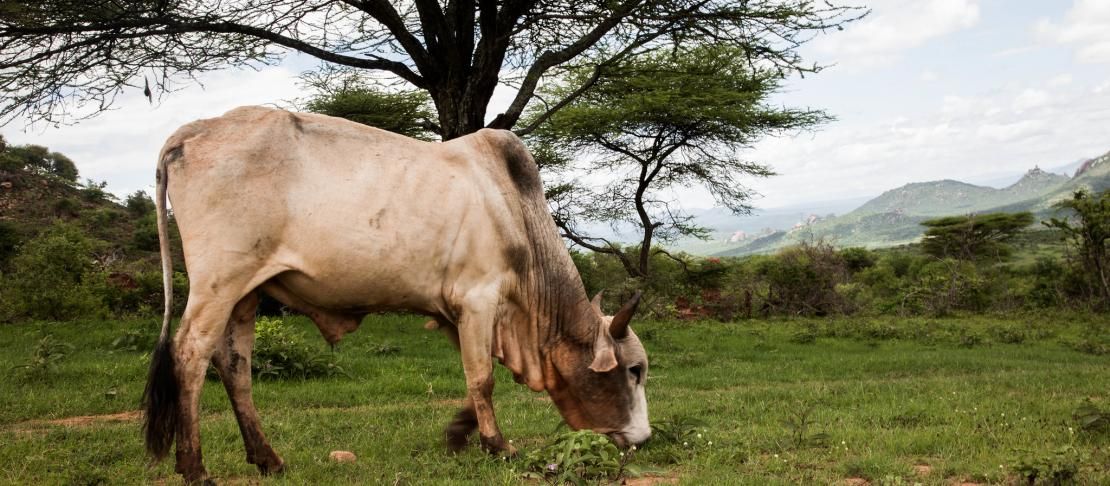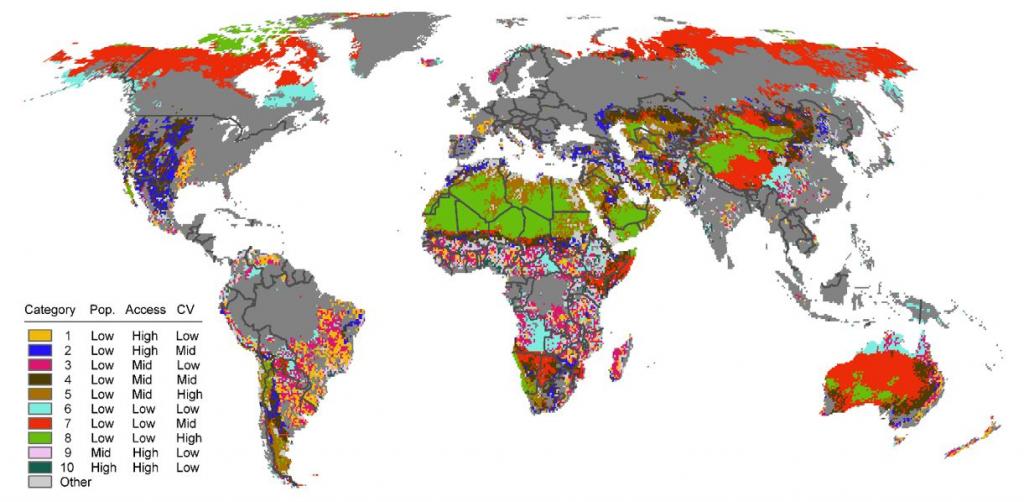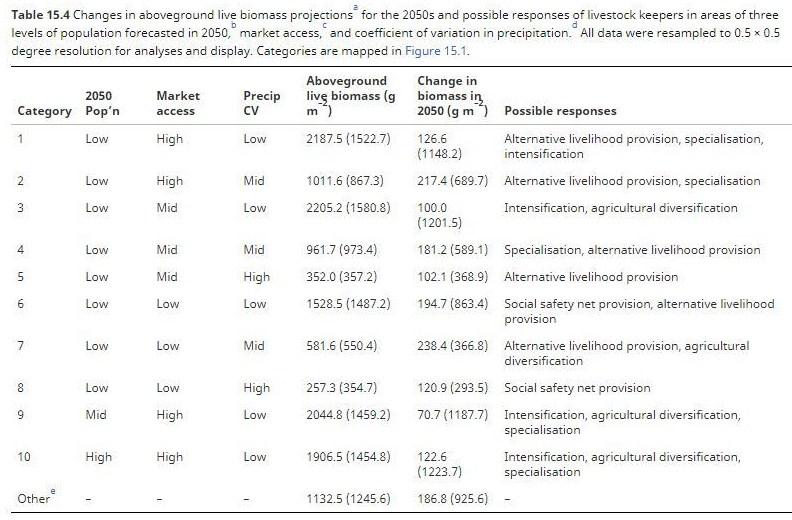How will climate change impact rangelands in the next few decades?

Philip Thornton contributed a chapter to Grasslands and Climate Change, the latest volume of the Ecological Reviews series. In this post Philip tells us more about the chapter, which explains the impacts of climate change on open grasslands used for livestock grazing.
There is considerable uncertainty regarding the effects of climate change on rangelands, not only because of uncertainty in future climate projections but also because of limitations to current knowledge of some of the key interactions between climatic, atmospheric and biological variables.
Possible future system changes
We undertook a tentative analysis to see if ‘hotspots of change’ could be identified in the global rangelands, along with possible responses.

Projected changes in aboveground live biomass in the rangelands for the 2050s categorised into 10 combinations of population, access and precipitation CV (see footnotes to the table below for details).
We categorised the rangelands into 10, based on combinations of human population in 2050 for Shared Socio-Economic Pathway 2 (‘Middle of the Road’) (Murakami and Yamagata 2016); market access in terms of travel time to the nearest city of 50,000 inhabitants or more in 2000 (Nelson 2008); and the coefficient of variation of precipitation, estimated for the 2050s using an empirical relationship between annual rainfall and rainfall CV (Jurkovic and Pasaric 2013). Here we assume climate stationarity to the 2050s, which may well not be the case, although no change in this relationship was found over the second half of the twentieth century (Jurkovic and Pasaric 2013). These 10 categories are mapped in the figure, and characterised in the table below in terms of projections of their aboveground live biomass changes to 2050s, using an ensemble of seven climate models, RCP 8.5 (a high emissions scenario), and the dynamic rangeland model G-Range (Boone et al. 2018). While the ensemble mean biomass changes to the 2050s are projected to be positive for each category, there is considerable spatial variability in these biomass changes; these are explored in the Boone et al. (2018) paper.

The table also includes a qualitative assessment of possible responses in each category. For example, category 1 is characterised by low population density, good market accessibility (a livestock keeper being able to travel to the market and back within one day), and low rainfall variability. In this category, modest increases in aboveground live biomass are projected to the middle of the century, although there may be significant spatial variation. In such places (parts of southern-central USA, SE Brazil, and parts of the African humid tropics, for instance), non-livestock-based livelihoods may well be possible, as well as specialisation in, and intensification of, production. There are likely to be fewer options for places in category 8 (parts of central Australia, much of the Sahara, and NE China, for instance): low population densities, far from markets, with high annual rainfall variability; percentage changes in live biomass may be large, but the baseline is very low. In such places, the provision of social safety nets will be the priority, or livelihoods not based on livestock. Interestingly, a large proportion of category 9 sites are located across the wetter zones of West and East Africa (medium populations, close to urban markets, with low rainfall variability), suggesting that there may be substantial opportunities for intensification, diversification, and specialisation of land use in some of these areas.
Enablers of change and the unpredictability of the future
A key question is whether change in agricultural systems to the middle of the century is in any way predictable, allowing technological, informational, and policy interventions and investments to be targeted at the relatively small scales appropriate to addressing local context. In our chapter, we discussed this in relation to three overlapping enablers (or dis-enablers) of change: governance, economics, and innovation.
Governance: The vulnerability of pastoralists to global change is particularly affected by property and grazing rights. While government protection of proprietary rights can reduce conflict between communities over natural resources, this protection needs to be unbiased rather than producing assymetries between pastoralist groups. Identifying the winners and losers from changes in land ownership and use of pastoral lands in the coming decades is a key challenge for the research agenda.
- Economics: In many pastoral systems, cash transfers from social protection programmes and remittances from pastoralists who migrate out of pastoral areas for wage labour in towns and cities will become increasingly important.
- Innovation: Innovations in collaborative governance, such as community-based rangeland management, hold out promise for achieving socially just, economically viable and environmentally sustainable management of rangelands and the biodiversity they support.
Regarding the predictability of systems’ change, the uncertainities are very large, even as the rate of change accelerates. There is a need for more analyses that could contribute subtantially to increased understanding of the impacts of key change drivers in the rangelands, thereby improving the targeting of appropriate technological and policy-related interventions.
a From Boone et al. 2018, showing mean and spatial standard deviation for baseline in 2000, and projected change into 2050 based on RCP 8.5 and production modified by increased CO2 concentration.
b From Murakami and Yamagata 2016, for SSP 2 (‘middle of the road’) human population in 2050. Thresholds, in millions of people per km2 for categories Low, Mid, and High, were 0–0.163, 0.164–0.653, and 0.654 or greater.
c Adapted from Nelson 2008, representing travel time to the nearest city of 50,000 or more in 2000. Thresholds, in minutes of travel time, used for categories Low, Mid, and High, were 0–200, 201–600, and greater than 600.
d Calculated using a regression equation from Jurkovic and Pasaric 2013 and summed monthly precipitation from seven global circulation model results listed in Boone et al. 2018. Thresholds, in percent forecasted coefficient of variation for categories Low, Mid, and High, were 15.56–17.68, 17.69–21.92, and greater than 21.93.
e Sixteen classes that included fewer than 1000 half-degree cells each (mean, 247 cells) were merged into this class.
References:
Boone RB, Conant RT, Sircely J, Thornton PK, Herrero M. Climate change impacts on selected global rangeland ecosystem services. Global Change Biology. 2018;24(3):1382–93.
Jurkovic RS, Pasaric Z. Spatial variability of annual precipitation using globally gridded data sets from 1951 to 2000. International Journal of Climatology. 2013;33(3):690–8.
Murakami D, Yamagata Y. Estimation of gridded population and GDP scenarios with spatially explicit statistical downscaling. arXiv preprint arXiv:161009041. 2016.
Nelson A. Estimated travel time to the nearest city of 50,000 or more people in year 2000. Global Environment Monitoring Unit–Joint Research Centre of the European Commission, Ispra, Italy. 2008.
This blog was originally posted on The Applied Ecologist's Blog.
Philip Thornton is the CCAFS Priorities and Policies for CSA Flagship Leader.
